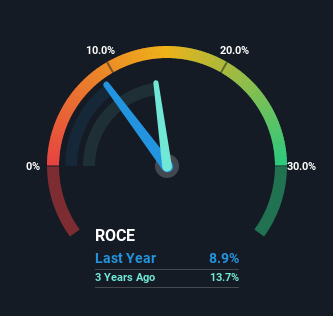HNI's (NYSE:HNI) Returns On Capital Tell Us There Is Reason To Feel Uneasy
What underlying fundamental trends can indicate that a company might be in decline? Businesses in decline often have two underlying trends, firstly, a declining return on capital employed (ROCE) and a declining base of capital employed. Ultimately this means that the company is earning less per dollar invested and on top of that, it's shrinking its base of capital employed. So after we looked into HNI (NYSE:HNI), the trends above didn't look too great.
Return On Capital Employed (ROCE): What Is It?
If you haven't worked with ROCE before, it measures the 'return' (pre-tax profit) a company generates from capital employed in its business. Analysts use this formula to calculate it for HNI:
Return on Capital Employed = Earnings Before Interest and Tax (EBIT) ÷ (Total Assets - Current Liabilities)
0.089 = US$97m ÷ (US$1.6b - US$492m) (Based on the trailing twelve months to July 2022).
So, HNI has an ROCE of 8.9%. On its own that's a low return on capital but it's in line with the industry's average returns of 9.0%.
Check out our latest analysis for HNI
Above you can see how the current ROCE for HNI compares to its prior returns on capital, but there's only so much you can tell from the past. If you'd like, you can check out the forecasts from the analysts covering HNI here for free.
The Trend Of ROCE
There is reason to be cautious about HNI, given the returns are trending downwards. Unfortunately the returns on capital have diminished from the 17% that they were earning five years ago. Meanwhile, capital employed in the business has stayed roughly the flat over the period. Since returns are falling and the business has the same amount of assets employed, this can suggest it's a mature business that hasn't had much growth in the last five years. So because these trends aren't typically conducive to creating a multi-bagger, we wouldn't hold our breath on HNI becoming one if things continue as they have.
What We Can Learn From HNI's ROCE
In summary, it's unfortunate that HNI is generating lower returns from the same amount of capital. Investors haven't taken kindly to these developments, since the stock has declined 18% from where it was five years ago. With underlying trends that aren't great in these areas, we'd consider looking elsewhere.
On a separate note, we've found 2 warning signs for HNI you'll probably want to know about.
While HNI may not currently earn the highest returns, we've compiled a list of companies that currently earn more than 25% return on equity. Check out this free list here.
Have feedback on this article? Concerned about the content? Get in touch with us directly. Alternatively, email editorial-team (at) simplywallst.com.
This article by Simply Wall St is general in nature. We provide commentary based on historical data and analyst forecasts only using an unbiased methodology and our articles are not intended to be financial advice. It does not constitute a recommendation to buy or sell any stock, and does not take account of your objectives, or your financial situation. We aim to bring you long-term focused analysis driven by fundamental data. Note that our analysis may not factor in the latest price-sensitive company announcements or qualitative material. Simply Wall St has no position in any stocks mentioned.
Join A Paid User Research Session
You’ll receive a US$30 Amazon Gift card for 1 hour of your time while helping us build better investing tools for the individual investors like yourself. Sign up here

 Yahoo Movies
Yahoo Movies 
